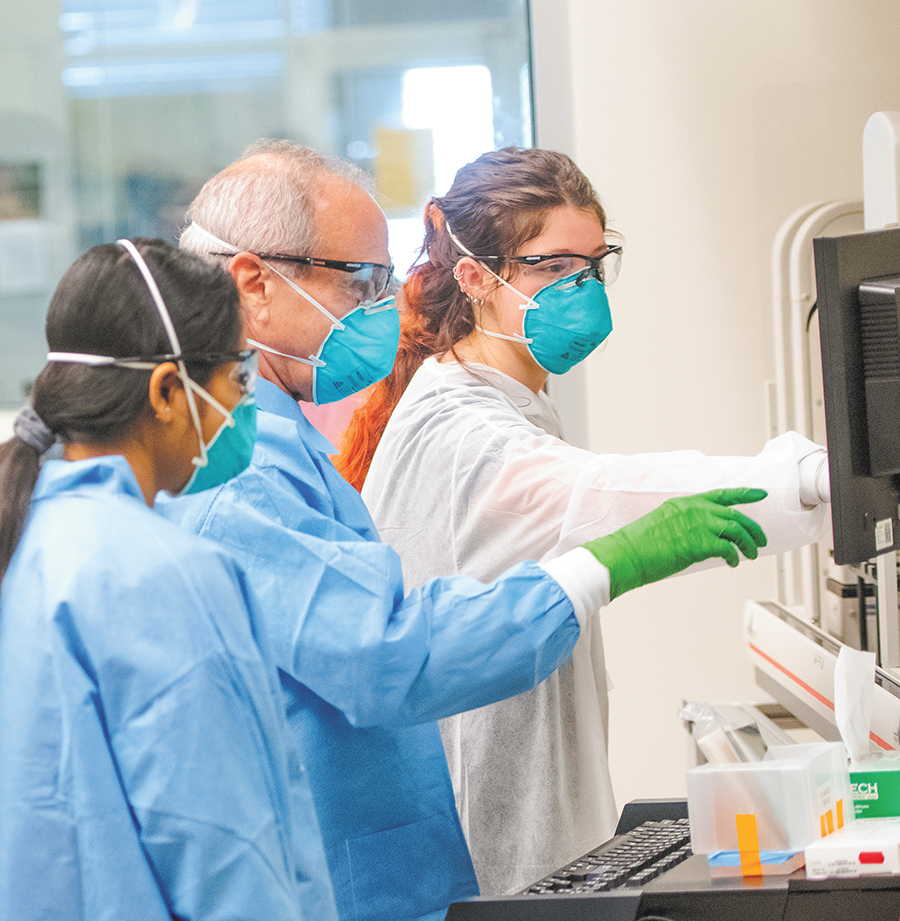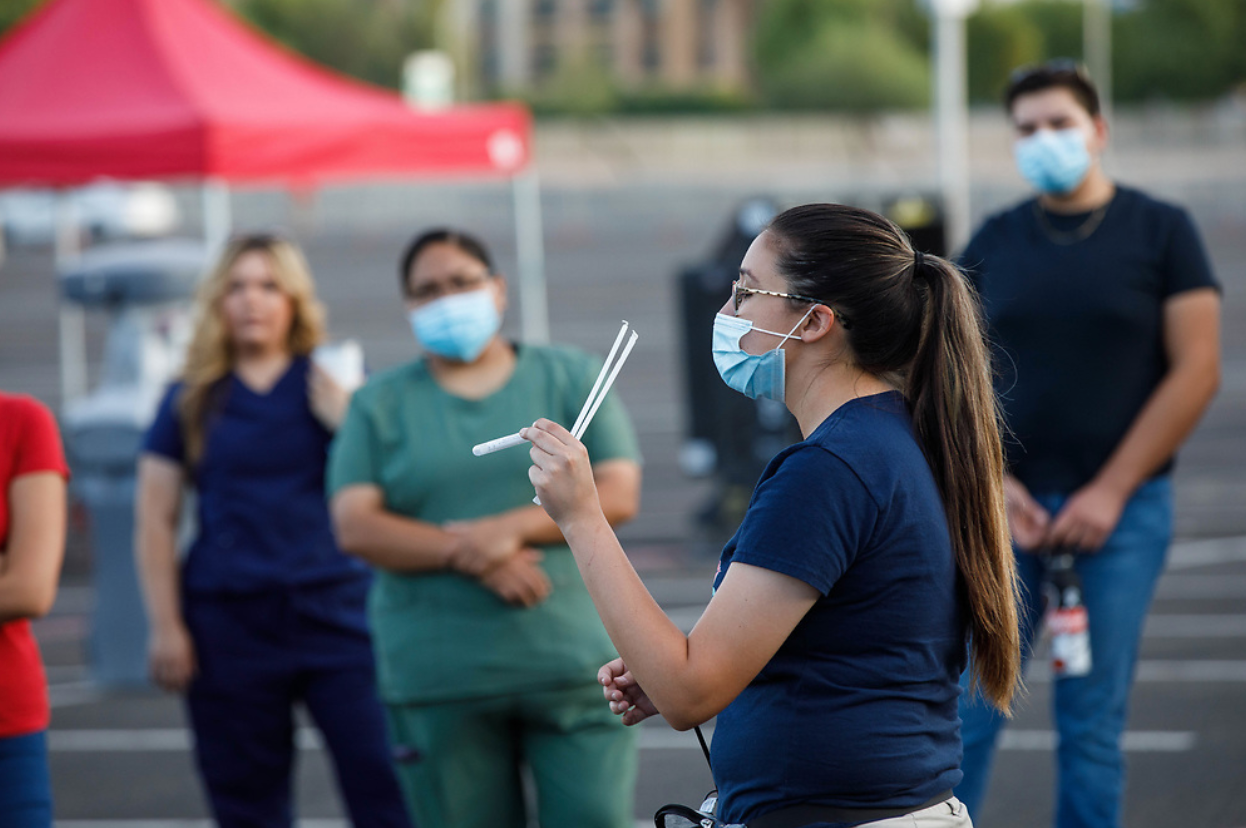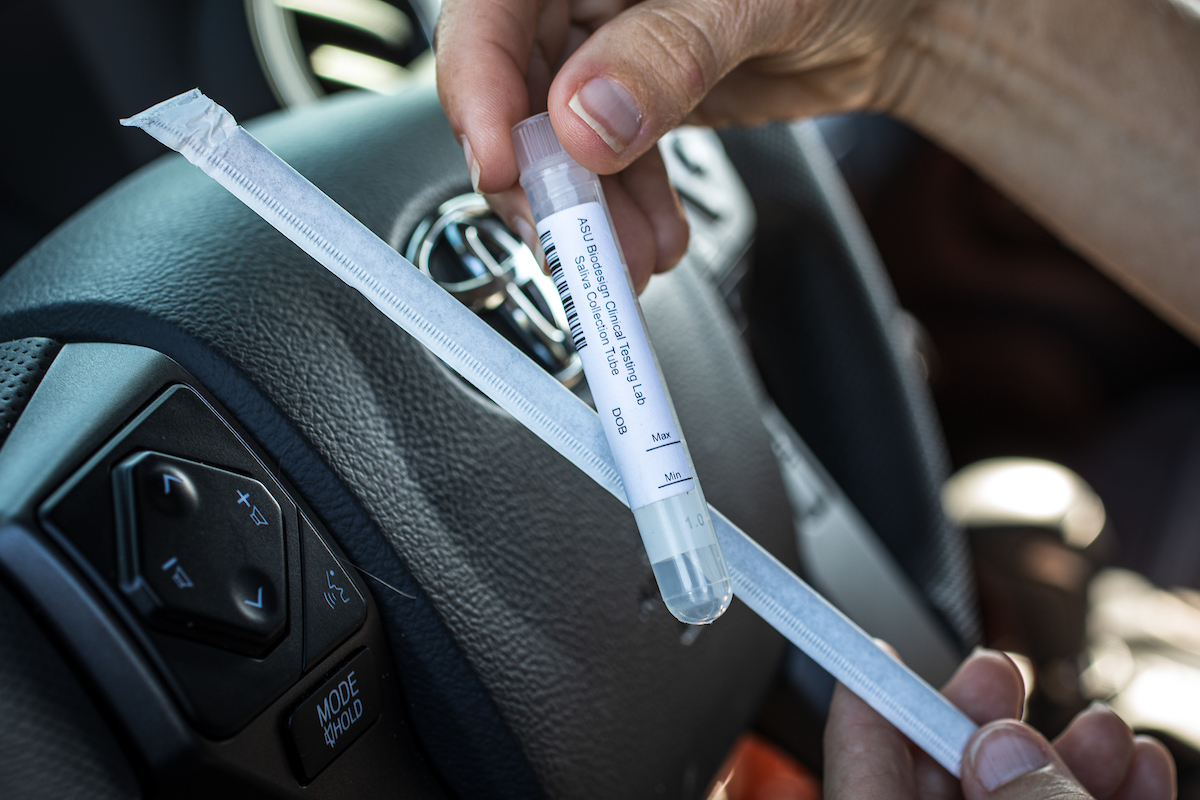Editor's note: This story originally appeared in the fall 2020 issue of ASU Thrive magazine.
On the morning of March 11, clinicians at the Arizona Department of Health Services reported three new cases of the novel coronavirus in the state, and Gov. Doug Ducey declared a public health emergency.
Dr. Joshua LaBaer, executive director of the Biodesign Institute at ASU, was in his office when he heard about Ducey’s declaration. LaBaer spends a lot of his time thinking about infectious disease even when there’s not a pandemic, and yet the novel coronavirus was unlike anything ever seen.
“We took it very seriously,” LaBaer said. “Our epidemiologists were saying this is going to spread.”
But in the emerging crisis, he saw an opportunity to save lives.
Making rapid saliva tests
Founded in 2003, the Biodesign Institute with its 17 research centers has a broad mandate to conduct research at the intersection of global health, sustainability and security. In March 2020 it was clear that widespread and rapid testing would be critical to combat the novel coronavirus, and that LaBaer’s team was well-equipped to make that happen.
Biodesign Institute Director Joshua LaBaer in one of the testing labs.
Before the pandemic, LaBaer’s group won a contract from the Department of Defense’s Biomedical Advanced Research and Development Authority, or BARDA, to develop tests that could quickly identify the level of radiation exposure in individuals. These tests were meant to save lives in dangerous, rapidly developing situations like a nuclear accident, but many of the techniques and equipment could also be used to detect a coronavirus infection.
“We had the equipment, the expertise and the knowledge to pivot to COVID-19 testing,” LaBaer said.
First his team started with nasopharyngeal swab tests, but within weeks made the decision to start developing saliva tests instead. Spitting in a tube doesn’t involve the same physical discomfort that sticking a long swab up your nose does, which could encourage more people to get tested. The novel saliva tests are faster and more cost-effective because they don’t require trained medical staff to administer.
“You can scale up saliva tests,” LaBaer said.
Building a medical laboratory
Prior to the pandemic, the institute was purely a research facility; it wasn’t designed to handle clinical work, which requires equipment, personnel and procedures that meet stringent federal regulations. LaBaer tapped Dr. Carolyn Compton, who is trained as a clinical pathologist, to lead the transition.
“There was no medical laboratory at the Biodesign Institute, so we had to create it,” said Compton, a professor in the School of Life Sciences who now serves as the institute’s medical director.
Rapidly pivoting a lab from academic to clinical work would be a Herculean task even under normal circumstances, but the fact that a lot of this clinical work would have to happen under extremely unusual clinical conditions, like taking samples from participants while they sat in their cars in a parking lot, added to the complications.
Compton’s main duty was making sure the lab met the strict standards of the Clinical Laboratory Improvement Act that governs how labs that produce medical data must monitor and verify the people and instruments doing the tests.
“We have to record every temperature change and every deviation of the performance of our equipment,” Compton said. “CLIA inspections are a very serious thing.”
And since the lab wouldn’t just be doing analysis but handling sample collection and distribution of results as well, that also meant designing a workflow that is compliant with federal privacy laws from start to finish. For Compton and her team, that meant mountains of additional paperwork and still more training for research staff to ensure patient privacy.
Compton’s extensive experience as a clinical pathologist made it possible to rapidly transition LaBaer’s lab to a clinical testing facility. But she says she wouldn’t have taken on this weighty responsibility in the first place if LaBaer hadn’t already laid the foundation for the initiative’s success. She says the lab’s previous work with BARDA enabled its fast pivot to COVID-19 testing because it meant LaBaer and his team were already familiar with the stringent federal requirements for operating a clinical lab.
"Turnaround time is key. If results take a week then it’s going to be too late. Testing is only an intervention if you can get an answer back to somebody quickly.”
— Biodesign Director Joshua LaBaer
“Many academic labs are purely discovery labs and don’t do product development for deployment to the health care system,” Compton said. “Josh’s laboratory wasn’t just sophisticated in terms of its technology, it was sophisticated in terms of its knowledge of regulatory requirements.”
By May, Biodesign Institute researchers had successfully created the first saliva-based COVID-19 test in the state. Soon after, they began piloting the test with a network of first responders in Phoenix who were at the greatest risk of exposure to the virus. By comparing the results of these tests with nasopharyngeal swabs from the same individuals, the Biodesign Institute found that the saliva-based tests were just as accurate.
The Biodesign Institute expanded its saliva test network to include students and employees, and soon was processing up to 1,400 samples a day. By early July, the diagnostic system rolled out to the general public, and ASU announced a partnership with the Arizona Department of Health Services to set up testing sites in underserved communities around the state. The goal of this $12.7 million partnership is to provide free saliva tests for up to 100,000 Arizonans.
In a press release when the collaboration was announced, Gov. Doug Ducey said: “This critical partnership will have an immediate impact in the fight against COVID-19 and help us surge testing where it’s needed most. My thanks to Arizona State University for their continued partnership and for continuing to step up to aid public health in innovative and invaluable ways.”
Setting up testing sites without tying up health care workers
Dorinda Wilson is an events manager at ASU, and she’s been helping many of the university’s partners organize COVID-19 testing sites since the beginning of April. Wilson heads a team of fewer than 10 people, and the events they run usually don’t involve testing people or donning head-to-toe personal protective equipment. But the same sorts of logistical skills still apply.
“Events people know how to work under pressure and think on our toes,” Wilson said. “That mindset works in this pandemic, and we bring that skill set to the testing sites.”
Instead of planning events like homecoming and ASU Open Door, Breanna Carpenter now gets up every morning at 2:30 a.m. to be at a saliva-testing site early enough to set everything up before the clinical crew arrives at 6 a.m. for daily training.
So when the Biodesign Institute contacted Wilson to ask for help setting up and running saliva testing sites, she and her team were ready.
For weeks the events team had been using the Biodesign Institute auditorium to train other organizations to set up testing facilities of their own. And starting in July, the team has also been managing the two public testing sites — one at the Cardinals football stadium and the other at Ak-Chin Pavilion — created through the university’s partnership with the Arizona Department of Health Services, where they’re responsible for safely collecting the samples and getting them back to the institute for testing.
“Events people know how to work under pressure and think on our toes. That mindset works in this pandemic, and we bring that skill set to the testing sites.”
— Dorinda Wilson, events manager at ASU
LaBaer estimates that the institute conducted around 10,000 saliva tests during the first few weeks of the public program. It typically takes less than 48 hours for ASU to return results, versus the seven to 12 days, according to The New York Times, that it was taking large commercial lab companies in July.
“Turnaround time is key,” LaBaer said. “If results take a week then it’s going to be too late. Testing is only an intervention if you can get an answer back to somebody quickly.”
By mid-August, LaBaer expected the institute to have more than quadrupled its testing capacity. He said it was aiming for around 16,000 tests per day.
Data modeling
The fight against COVID-19 includes Biodesign Institute data models that serve many purposes. At the most basic level, they help keep the public informed about the virus’s trajectory in Arizona on an interactive COVID-19 dashboard on the Biodesign Institute’s website. Created in March, it’s updated daily with case counts, deaths and daily tests.
The models also help public health officials get ahead of hot spots. Timothy Lant, director of program development for ASU Knowledge Enterprise and an applied mathematician, has been working closely throughout the pandemic with officials from Maricopa County and the Arizona Department of Health Services to help them with their modeling to stay ahead of the virus.
The models also help inform policy decisions about things like when it’s safe to reopen businesses or whether wearing masks in public should be mandatory.
Abba Gumel, a foundation professor of mathematics at ASU, describes his research as “the use of mathematics to save lives.” His models have largely focused on the effectiveness of nonpharmaceutical interventions like masks and physical distancing for fighting the virus.
His results have been unambiguous: Wearing masks works, and if it had been implemented sooner in Arizona it could have saved hundreds of people from dying. Gumel collaborated with several colleagues and students from ASU on his work, including Matthew Scotch, assistant director of the Biodesign Center for Environmental Health Engineering and an associate professor at the College of Health Solutions. Gumel says his research couldn’t have happened without the support of a university that prioritizes transdisciplinary collaboration.
“ASU is gaining the reputation now as a world-class center for research in mathematical biology,” Gumel said. “It’s one of the best places to use mathematics to understand how diseases spread and how to control them, and that’s because it’s not something that can be solved by public health people, modelers, mathematicians or computer scientists alone. It requires people from different disciplines to work together.”
Using interdisciplinary approaches
Biodesign Institute researchers have also been supported by other ASU departments. In late March, the College of Health Solutions announced it would award up to $100,000 for transdisciplinary pandemic-related research projects. One of the five grants of $20,000 was awarded to ASU’s Matthew Scotch to create a genome repository of the virus from patients with COVID-19 in Arizona. This will help researchers monitor changes in the virus’s RNA to understand how the virus evolves.
“The College of Health Solutions is designed to really make a difference in health outcomes, and to really serve the community,” said the college’s dean, Deborah Helitzer. “And with COVID-19 there was a tremendous opportunity to rally the faculty around a topic and to bring together all of our transdisciplinary work.”
An example of the saliva-collection vial and straw that participants receive at ASU testing sites. Photo by Charlie Leight/ASU Now
Serving Arizona
The university’s response to the crisis helped to bring down cases through aggressive and rapid testing that delivers a result in 48 hours or less. Other reasons for the decline in cases include modeling that supports the use of face coverings and modeling that supports physical distancing. From a peak of a seven-day moving average of 3,800 new cases in July, Arizona had a seven-day moving average of 435.6 new cases a day on Sept. 10.
ASU’s response hinged upon the institute’s ability to rapidly leverage the expertise of dozens of researchers to save lives. This was largely possible because of research grants and programs like Arizona’s Technology and Research Initiative Fund, a critical source of funding that comes out of a voter-approved sales tax. As LaBaer said, “The institute was built on TRIF.”
“We are members of the community, we have family here,” LaBaer said. “Doing things like opening public testing sites and developing tools that the public can use helps keep that community safe. We’re here to help, and we take that mission very seriously.”
Get a free test and fast results
The saliva testing being done at remote sites around the Valley and other parts of Arizona through an ASU and Arizona Department of Health Services partnership is currently free. To preregister and reserve a testing time, go to asubioempportal.pointnclick.com.
Written by Daniel Oberhaus, a staff writer at Wired magazine and the author of “Extraterrestrial Languages” (the MIT Press). An ASU alumnus, ’15 BA in English (creative writing) and philosophy, he is a graduate of Barrett, The Honors College.
Top photo: Clockwise from top left: Biodesign Institute's Building C, ASU's saliva test for COVID-19, Biodesign Institute Director Joshua LaBaer oversees a machine that helps the lab test thousands of samples a day, a test site volunteer scans a participant's appointment QR code, the Biodesign lab expansion, and drive-thru testing. Photos by ASU
More Health and medicine
College of Health Solutions program doing its part during Salute to Service
It wasn’t always easy for Marine veteran Chuck Hale when he first returned to civilian life. But he’ll never forget the help he received from a fellow former service member.“The first vet that helped…

What makes human culture unique?
Why is human culture — the shared body of knowledge passed down across generations — so much more powerful than animal cultures?“What’s special about our species?” is a question scientists have…

ASU honors students work on HPV research as part of Barrett College's largest-ever group thesis
Not every undergraduate student comes across the opportunity to do research as part of a team. Even fewer have had the chance to join a team of 86 students doing multidisciplinary research with real-…



